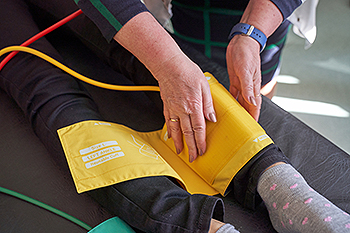
Peripheral artery disease, or PAD, affects approximately 10 million adults in the U.S., with about five percent of those over 50. The condition is slightly more prevalent in men. Peripheral artery disease is caused by clogged arteries that block the flow of blood to the lower legs and feet. Risk factors include high cholesterol, smoking, diabetes, and hypertension. Others are family history, chronic renal failure, obesity, and physical inactivity. Common symptoms can include intermittent pain with exercise and severe pain in legs, especially at night. Additional signs of PAD are numbness, weakness, and muscle atrophy in legs, coldness and color changes in feet, and hair loss on the arms and legs. Thickening toenails and poor wound healing, which may lead to ulcers and gangrene, are also telltale signs of PAD. Prompt recognition of symptoms and risk factors is important to prevent complications that can include tissue damage. If you are experiencing symptoms of PAD in the lower leg and feet, it is suggested that you visit a podiatrist for a thorough exam.
Peripheral artery disease can pose a serious risk to your health. It can increase the risk of stroke and heart attack. If you have symptoms of peripheral artery disease, consult with Zina Cappiello, DPM from Dr. Zina B. Cappiello DPM, LLC. Our podiatrist will assess your condition and provide you with quality foot and ankle treatment.
Peripheral artery disease (PAD) is when arteries are constricted due to plaque (fatty deposits) build-up. This results in less blood flow to the legs and other extremities. The main cause of PAD is atherosclerosis, in which plaque builds up in the arteries.
Symptoms
Symptoms of PAD include:
- Claudication (leg pain from walking)
- Numbness in legs
- Decrease in growth of leg hair and toenails
- Paleness of the skin
- Erectile dysfunction
- Sores and wounds on legs and feet that won’t heal
- Coldness in one leg
It is important to note that a majority of individuals never show any symptoms of PAD.
Diagnosis
While PAD occurs in the legs and arteries, Podiatrists can diagnose PAD. Podiatrists utilize a test called an ankle-brachial index (ABI). An ABI test compares blood pressure in your arm to you ankle to see if any abnormality occurs. Ultrasound and imaging devices may also be used.
Treatment
Fortunately, lifestyle changes such as maintaining a healthy diet, exercising, managing cholesterol and blood sugar levels, and quitting smoking, can all treat PAD. Medications that prevent clots from occurring can be prescribed. Finally, in some cases, surgery may be recommended.
If you have any questions, please feel free to contact our office located in Clifton, NJ . We offer the newest diagnostic and treatment technologies for all your foot care needs.
